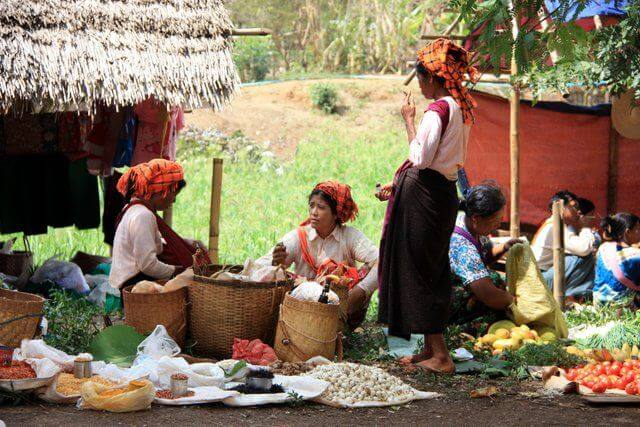
Ladies at Ywama Market
Ywama Village
Our boat journey started with the obligatory trip to a couple of shops – this time a silversmiths and a pottery. It was all very attractive, but highly unlikely to survive the baggage handlers on our flights back to China.
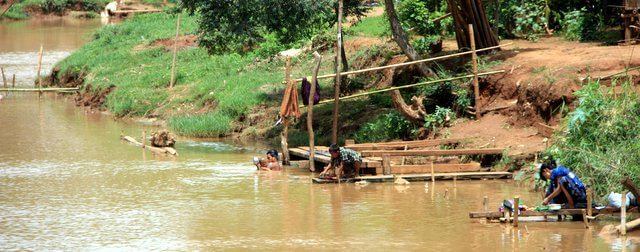
Laundry day
In the back of the store was an unexpected sight – members of a local tribe who seek to stretch their necks with golden hoops. The elderly lady did indeed have a very long neck, but her purpose in life mainly seemed to be as a curiosity for tourists. Worse was her grand-daughter who was unenthusiastically being groomed and stretched to become her successor.
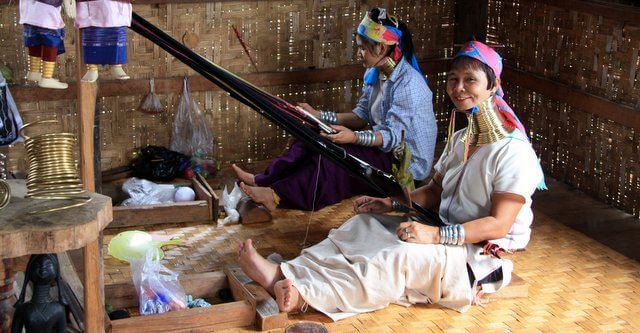
The long necked ladies of Inle Lake. Note the spring like hoops on the left.
I snapped a photo then immediately felt a bit awkward. This feeling wasn’t shared by the middle-aged English couple who were there at the same time. Their conversation went along these lines:
“Mingalaba – see we’ve learnt your language” – Mingalaba means hello. Now you’re fluent.
“Take a photo of me with the freak” – this despite it being clear that nearly everyone in the room spoke English.
“Now take a video” – followed by the portly man bear-hugging the elderly lady and shaking her to make the golden hoops jingle.
They then turned towards the granddaughter who understandably walked out.
“Mingalaba” again and they left without buying anything.
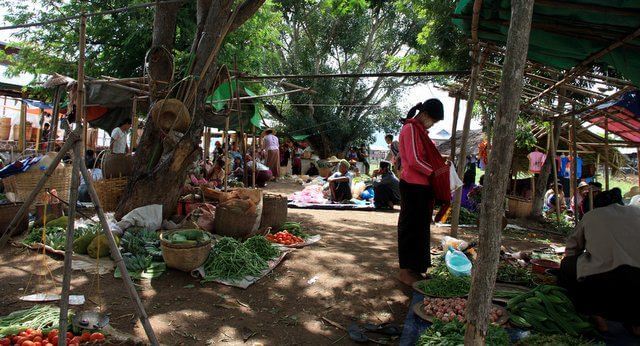
Ywama Market
Ywama Market
The market rotates round the villages on the shore of Inle Lake, recurring every five days. Today the market had come to Ywama. Boats selling shiny fresh fruit and vegetables drifted between the stilted houses. Those people selling tourist trinkets took up residence on an island containing a forest of white stupas.
As the morning continued it was getting too hot wandering around in the sun and humidity. There was nothing new here so we went back to look for our long boat driver amongst the flotilla of tourist vessels come to visit the market.
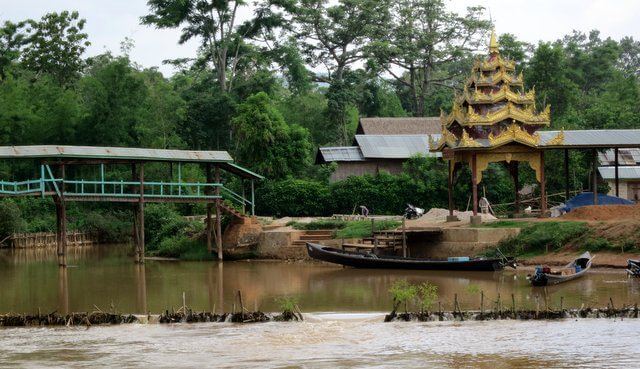
Each ‘river step’ raised the boat up by a few inches – is there a proper name for these?
Our underwhelmed demeanour soon disappeared as we set off up a channel away from the Ywama and the main lake. We puttered along faster than normal as the river was interrupted by a series of barricades, each letting through a small waterfall. At higher speed the boat could climb up these, and by passing a few dozen slowly raise the boat into the hills.
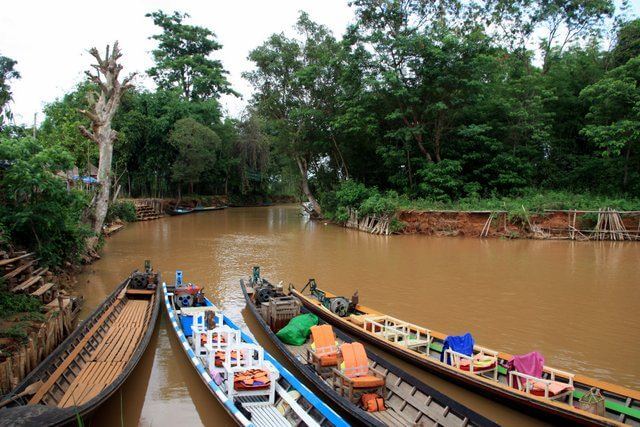
Boats moored at the jetty in Indein. Our boat is in the middle with the green bag. I was slightly jealous of the fancy boat on the left.
Indein
Our journey through the jungle ended at the village of Indein. The river banks around Indein are just a collection of expensive restaurants and even more expensive toilets, but walk through these and past the school and you get to Shwe Inn Thein.
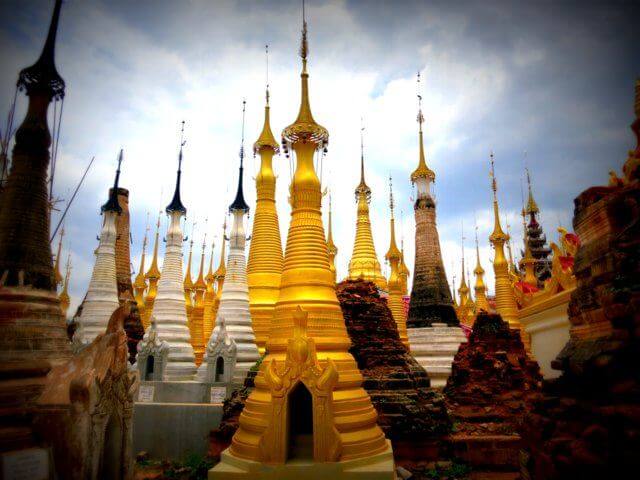
Shwe Inn Thein stupas
Shwe Inn Thein
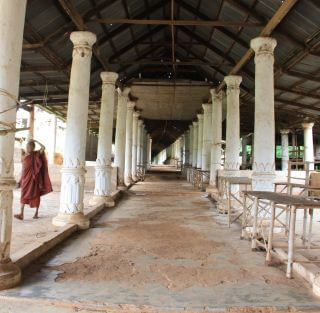
Steps leading to Shwe Inn Thein
Here a set of covered steps with hundreds of wooden columns lead the way up the hill. The steps must once have been beautiful but are now lined with trestle tables stacked with low quality souvenirs. Everything is available for a lucky price…
Reaching the top of the hill you’re reminded to remove your shoes before continuing into the temple. More importantly, there’s a lady there with a fridge full of reasonably priced cold drinks.
The temple itself is quite small, but it’s set amongst a field of densely packed stupas. These range from new and white painted, to gold coated and ancient crumbling brick examples. The new ones are fine, but the real joy was getting lost amongst the vines curling around the decaying brick pillars.
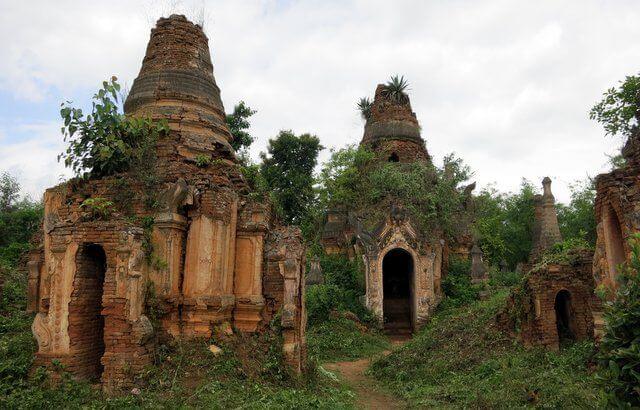
Crumbling stupas at Shwe Inn Thein
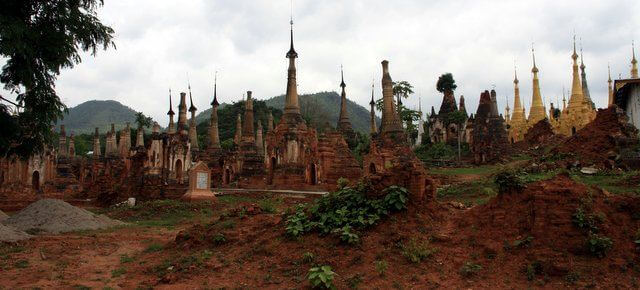
Stupas in various states of disrepair
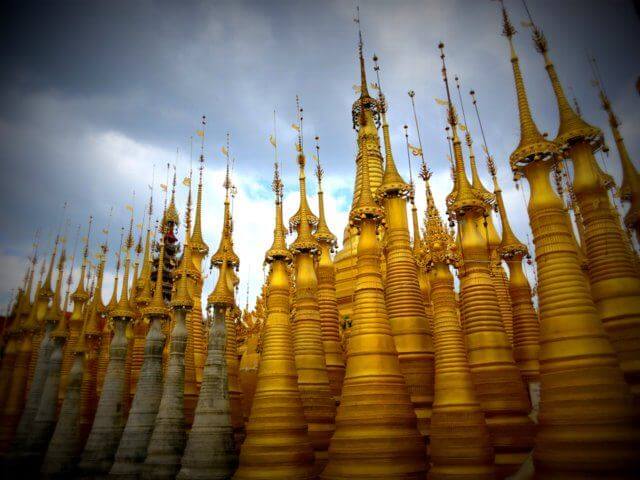
Stupas at the peak of Shwe Inn Thein
Back at the base of the hill our boat driver once again informed us that 1pm was the end of a full-day, which we couldn’t really dispute this far from the lake so headed back to Nyaunagshwe for drinks.






Pingback: @maritereh
Pingback: @LemuelRoem
Pingback: @AdvanceAbroad
Pingback: Micki & Charles (@BarefootNomads)
Steve, I’m absolutely in love with your series on Myanmar. Beautiful photos. Though I may have slapped the tourists who asked for the freak photo. You showed remarkable restraint.
It was tempting, but I didn’t want to tarnish the ladies opinion of us Brits any further by starting a fight in a pottery shop.
Pingback: @Backyard_Travel
Another incredible post and photos…awesome stuff…
Such lovely photographs of your Myanmar/Burma trip. Reading about the British couple left a sour taste in my mouth, though — as I’m sure it did yours.
Pingback: @JenniferMiner
What lovely pictures. I love the Stupas!
These photos are beautiful. Since I live in Thailand, Myanmar is a place I definitely plan on visiting. Thanks for this information and for giving me some ideas of what to do when I am there.
I can’t believe how those other tourists treated the locals. It makes me so disgusted to hear of this happening after they invited you into their shop!
Pingback: Cole and Adela (@FourJandals)
Pingback: @edventuremama
Pingback: John and Andrea (@InspirngTrvlrs)
Beautiful photos! The Shwe Inn Thein stupas are really interesting to me – how they are all packed so close together.
Steve, What a great series. Love the photos and stories. I cannot believe those people called them FREAKS. How did you not throw something at them? We met some “long necks’ at a refugee camp in N Thailand. I cannot believe how heavy those rings are.
Lisa
Pingback: Lisa Niver Rajna (@wesaidgotravel)
Pingback: Our Oyster (@our_oyster)
Where were the rude tourists from? I have my guesses already
These ones were British unfortunately.
Great photos! and well taken!
But I am just surprise that how those tourist did to the local!
Great photos and article! I haven’t been to Myanmar and dont know loads about it so this is really interesting. Thanks for sharing!
We are going to Myanmar next month, probably will go to Inle Lake if time is enough, could you please let me know how to figure out the date of the Market Day in Ywama Village, Is it recurring every five days from August 16 when you were there? Thanks!
Sorry, I’m not entirely sure what day it will be. It’s probably best to ask your hotel when you arrive in Yangon.